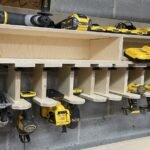Tool theft is a significant problem at job sites. Losing tool belts can be a significant setback for skilled workers who demonstrate their value and talent through the use of their tools. Therefore, it is essential to understand how to secure your tool belt and prevent theft? to safeguard workers’ livelihoods and businesses.
Secure Your Tool Belts By Using Best Tips
In this article, we will discuss some important tool theft prevention including using anti-theft devices, GPS tracking, secure storage, marking and registering tools, and implementing job site security measures.
Tips for Securing Your Tool Belt and Preventing Theft

Here are some tips for securing your tool belt and preventing theft:
Use of Anti-Theft Devices
- Utilize security tags, locks, and alarms to protect your power tools.
- Consider using hardened steel security chains and high-quality padlocks to secure your tools.
GPS Tracking
- Install GPS trackers on your tools to monitor and recover them in case of theft.
Secure Storage
- Store your tools in secure cabinets or locked toolboxes.
- Use lockable containers and on-site storage units for added security.
Marking and Registering Tools
- Deface the appearance of your tools to make them less appealing to thieves.
- Engrave your initials or other identifiers on your tools.
- Keep a list of your power tools, including their model and serial numbers, for easy reference.
By following these tips, you can significantly reduce the risk of tool theft and protect your investments.
Importance of Securing Your Tools
Securing your tools is crucial to prevent theft and avoid the potential consequences that come with it. Tool theft can result in financial loss, project delays, and even the inability to complete a job. Losing tools can be a significant setback for skilled workers who rely on their tools to demonstrate their value and talent.
Construction companies can become an easy target for theft, both during and after work hours. According to experts, the annual cost of job-site theft, including materials other than tools, is about $400 million. Therefore, it is essential to take preventive measures to secure your tools and protect your business.
Best Practices for Tool Security

Here are the best practices for tool security based on the provided sources:
Job Site Security
- Implement additional lighting around the job site to deter theft and vandalism.
- Use fencing to limit access to the site and make it tougher for unauthorized individuals to take supplies out.
- Install job-site security cameras to monitor the site and discourage theft.
Employee Training
- Train employees on the importance of tool security and the role they play in preventing theft.
- Promote a culture of security by encouraging workers to take responsibility for securing tools and equipment.
Inventory Management
- Conduct regular inventory checks to ensure all tools are accounted for.
- Document tools, including their model and serial numbers, to aid in recovery and deter theft.
By following these best practices, construction professionals can significantly reduce the risk of tool theft and protect their valuable equipment and assets.
The Final Words
In conclusion, safeguarding tool belts and equipment is paramount to protect against theft and its far-reaching consequences. The prevalence of tool theft at construction sites poses a significant threat to both the progress of projects and the financial stability of businesses.
Prioritizing tool security not only safeguards valuable equipment but also ensures the continuity of projects and the well-being of workers. By following these guidelines, individuals and businesses can significantly reduce the vulnerability of their tools to theft and minimize the potential impact on their livelihoods and operations.
Suggested Read:
FAQs (Frequently Asked Questions)
-
What are the most common types of anti-theft devices for power tools?
The most common types of anti-theft devices for power tools include security tags, locks, and alarms.
-
Can GPS trackers help in recovering stolen tools?
Yes, GPS trackers can help in monitoring and recovering stolen tools by providing real-time location information.
-
How do marking and registering tools help in tool security?
Marking and registering tools with a national database makes it easier to track and recover stolen tools, as well as prove ownership in case of recovery
-
What are some job site security measures to prevent tool theft?
Job site security measures include additional lighting, fencing, surveillance cameras, and secure storage options.
-
How can employee training contribute to better tool security?
Employee training can help promote a culture of security, emphasize the importance of tool security, and encourage workers to take responsibility for securing tools and equipment








